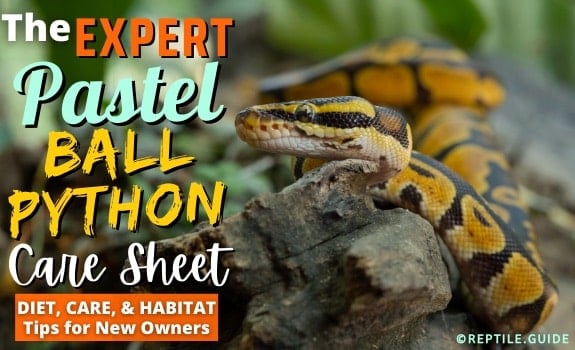The Pastel ball python is a common, basic color morph (opens in new tab) of the common ball python (Python reguis).
These docile, gentle snakes make incredible pets for beginners and experts alike, charming everyone with their beautiful colors and calm temperament.
In addition to their aesthetics and easygoing personality, Pastel Ball Pythons have very straightforward housing requirements that make them less intimidating for first time reptile owners.
However, although their habitat is fairly easy to maintain, there isn’t much wiggle room when it comes to deviating from temperature, humidity, and other parameters.
As you’ll soon discover, these snakes require very specific care that when ignored can lead to a medley of health consequences!
To learn more about these majestic snakes, simply keep reading!
In This Article
Pastel Ball Python Species Summary
First bred in 1997, the Pastel ball python owes its unique look to a co-dominant/incomplete dominant mutation.
Today, Pastel Ball Pythons are primarily renowned for their amazing ability to create exciting morphs. In fact, most breeders would say there aren’t too many other morphs a Pastel won’t breed beautifully with!
Some breeders are currently experimenting with combining the Pastel with the Bamboo Ball Python—a morph that is still relatively new to the market.
Whereas others may choose to combine the Pastel with the Enchi Ball Python Morph, Clown Ball Python Morph, or the Pinstripe Ball Python Morph to create unique markings.
All of this is worth keeping in mind if you’re looking for a Pastel that stands out from the rest.
Once selling for thousands of dollars, today you can purchase a Pastel Ball Python for as low as $75-100. This makes them highly accessible for first time snake owners.
⭐️ Fun Fact: Pastel Ball Pythons are non-venomous. They kill their prey by coiling tight around them and suffocating them.
Appearance & Colors
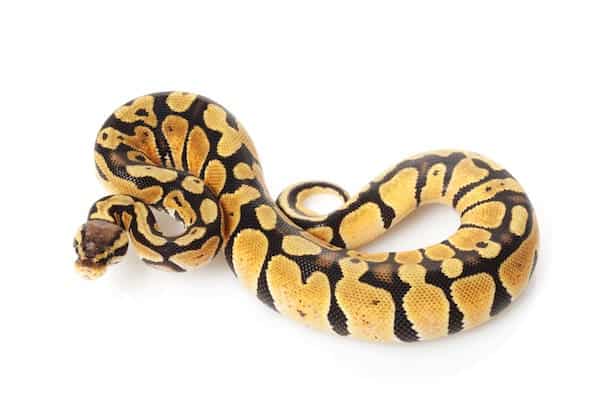
To a novice or first time owner, a Pastel Ball Python may look incredibly similar to that of a normal. However, to the educated eye, apparent differences are in fact quite obvious…
A true Pastel Ball Python is going to be much brighter in color than that of a normal with much more evident blushing on both the top of the head and vertebral scales (back scales).
More specifically, you’ll notice this bright yellow color typically extending from their belly up their sides. However, as they age, Pastels tend to dirty up a bit so this coloring can become more muted.
In regard to their overall pattern, it will be very similar to that of a Normal Ball Python. However, their belly will appear cleaner and whiter than a Normal with zero checkering or other dark marks
Many Pastel Ball Pythons also have green eyes. However, don’t rely on green eyes alone to identify them as Normals can sometimes have green eyes as well.
Pastels can also have white lips.
Breeding of two Pastel ball pythons will create the even more unique, Super Pastel ball python, which is often called “Purple Haze”. These snakes display erratic yellow patterns with more keyhole designs and are a purple blushing color.
Are you in love with the purple color? Discover the fascinating purple passion morph here.
Size
Like most ball python morphs, the Pastel Ball Python is between 3-5 feet long on average. However, some large females can reach 6 feet in length while some small males will measure a mere 2 feet in length.
As with most snakes, Pastel Ball Pythons demonstrate sexual dimorphism, so females are almost always longer and bigger.
At birth, most ball pythons will be 10 to 12 inches long, a length they quickly double in just 2 to 3 months time! However, as cute as this sounds, we do NOT recommend purchasing a hatchling.
Once done growing, you can expect your adult Pastel Ball Python to weigh between 2 and 4 pounds.
Lifespan
Captive Pastel Ball Pythons can live between 25-30 years. With proper care and love, your Pastel Ball Python can live a long and healthy life, providing you with many years of entertainment and companionship.
Pastel Ball Python Care Sheet
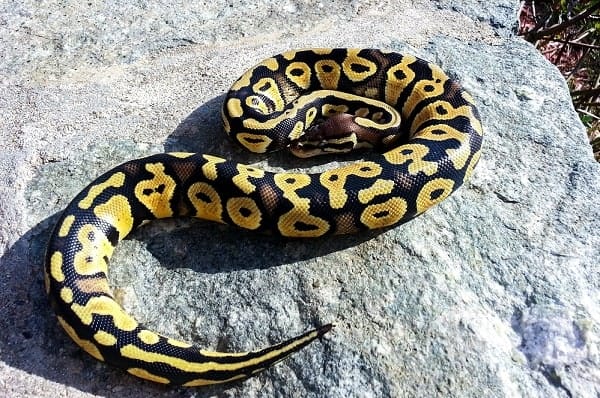
Enclosure Size & Dimensions
When it comes to ideal enclosure size online, there is unfortunately A LOT of misinformation. You see, many people seem to think that ball pythons can live their entire lives happily in a 40 gallon tank!
And while this size is certainly fine for juveniles and small snakes, it is by NO means enough space for large adults.
Instead, adult snakes (or those 3 feet in length or longer) should be placed in enclosure that is 120 gallons. These typically measure 48 inches long by 24 inches wide and 12 inches high.
Hatchlings will fare just fine in a 10 gallon or 20 gallon tank. As the progress to their juvenile stage, try to move them into a 40 gallon breeder as soon as they reach 20 inches in length.
As a generally rule of thumb, the enclosure should be between 1x and 1.5x as long as your snake. So, if your snake is 3 feet in length, aim for an enclosure that measures between 36 and 54 inches long.
PVC and plastic housing enclosures are typically best for Pastel Ball Pythons, as they are cheap to buy and retain humidity well. Most plastic enclosures are also opaque, providing your ball python with a sense of security.
However, most pet owners enjoy looking at their ball pythons, and so glass terrariums are also a good option.
Although they are generally more expensive and are worse at retaining moisture and temperature, glass terrariums allow easy viewing.
If a glass terrarium is used, it is recommended to cover at least three of the four sides with an opaque backing, to give your Pastel ball python a sense of security.
🤓 Expert Tip: Ball pythons are known to be expert escape artists! Unless you want to find them hiding under in your cupboards or cuddling you under the covers, use a secure lid. Lids should be mostly solid, with small openings for ventilation and humidity balance.
Substrate
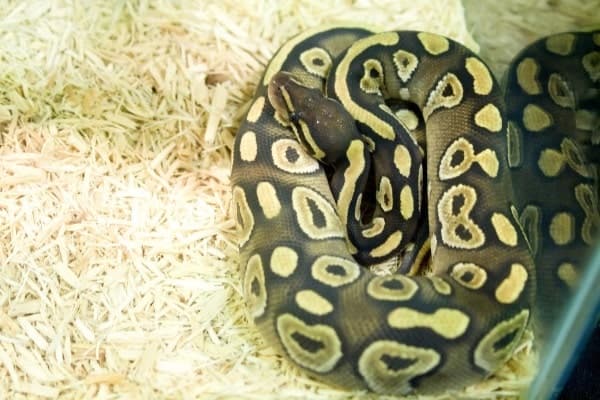
Once you have established the size of enclosure necessary for your Pastel Ball Python, it is now time to find the ideal substrate or flooring.
Ideal substrates include:
- Pesticide Free Topsoil: Excellent at retaining moisture, perfect for burrowing and readily available for pet owners.
- Cypress Mulch: Retains moisture well, safe, and effective substrate
- Coconut Husk/Fiber: Retains moisture well, allows for borrowing, easier to clean
You can also use paper towels or paper but neither product will provide enrichment for your pet and can be quite difficult to clean.
Substrates that should be avoided include cedar, pine or aspen shavings and all sand substrates.
For some ball python owners, color contrast is really important when considering the substrate, so consider how much you want your Pastel Ball Python to stand out when considering different options.
Temperature & Lighting
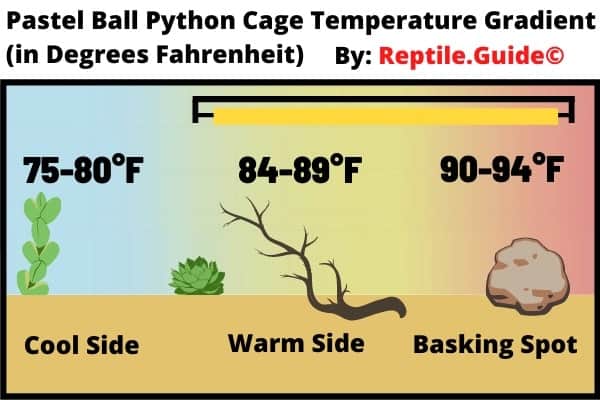
As Pastel ball pythons are cold blooded, they depend on external heat sources for heat and energy. Ball pythons use these external heat sources to thermoregulate their internal body temperature.
As such, heating lamps are 100% required in a Pastel Ball Python (or any ball python) enclosure.
A temperature gradient from one end of the enclosure to the other should be created. To create your gradient, you’ll first need two thermometers, one for the cool side and one for the warm side.
It is crucial that you place a hide on BOTH the cool and warm side of the enclosure.
Cool Side: 75-80 degrees Fahrenheit
Warm Side: 84-89 degrees Fahrenheit
Basking Spot: 90-94 degrees Fahrenheit
Nighttime Temperature: 72-80 degrees Fahrenheit
Overall, temperatures should stay above 70 degrees Fahrenheit but below 96 degrees Fahrenheit.
Undeniably, the BEST source of heat during the daytime will be a heat lamp placed overtop the enclosure/terrarium.
A heat lamps mimic the sun best, giving your Pastel ball python a more realistic and natural environment. Additionally, overhead heat sources allow your snake to slither inside their hides or under cover to escape the heat if they desire.
Also, please note that if you have an especially large enclosure, you may find it helpful to use more than 1 heat lamp. Ideally, heat lamps and all other lighting should be kept on for 10-12 hours daily.
Lastly in regard to heat sources, NEVER under any circumstance rely on heat rocks as these are notorious for burning reptiles. Don’t let any pet store employee tell you differently!
At night make sure the heat lamps are turned off, so that you can adhere to your snake’s natural Circadian Rhythm.
🤓 Expert Tip: If you find at night that cage temps are slipping below 70 degrees, consider adding a ceramic heat emitter (CHE) to raise the temperature a little. However, this isn’t absolutely necessary unless the temperature dips below 65 degrees Fahrenheit.
Humidity
As most houses are not anywhere near the idea humidity for a Pastel Ball Python, you may need to look into purchasing a humidifier or misting system.
Humidifier or not, your Pastel Ball Python will need humidity levels between 50 and 60%.
Problems with low humidity can contribute to issues with shedding and lead to other health issues as well.
If you struggle with humidity, consider changing up your substrate to something that retains more moisture, such as soil or cypress mulch. Although paper substrates are easy to clean, they do not hold humidity well, so they should be avoided.
Additionally, you can also try any of the following to raise the humidity level…
- Increase the size of your snake’s water bowl
- Add live, snake-friendly plants
- Partially cover the top of their enclosure with a damp towel
- Mist the substrate once or twice daily until damp
Water
Provide your Pastel ball python with a nice, large, water bowl filled with fresh tap or bottled water.
The water bowl should be big enough for your snake to take a dip, should it wish to do so, and also heavy enough so that your snake cannot tip it over.
Nobody wants to drink dirty water, so change your Pastel ball python’s water at least once every two days, or more frequently as it gets dirty.
Food & Diet
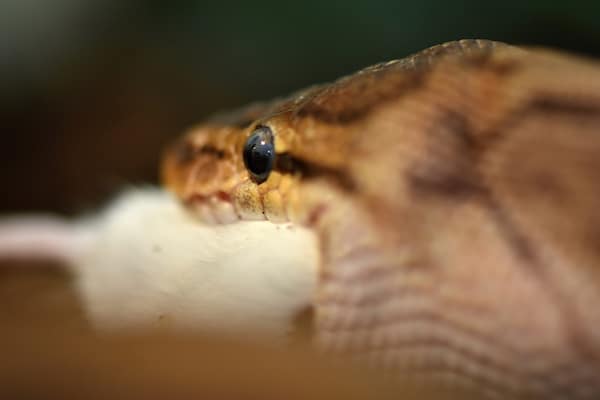
Pastel ball pythons are very easy to feed. All you need is a rodent once a week and your snake will be satisfied! They do not require any supplements or veggies, only a tasty rodent prey.
Your ideal feeding schedule should look something like this:
- Hatchlings: One small mouse every 5 days
- Juveniles: One large mouse or small rat every 7 days
- Adults: One rat every 10-14 days
Prey foods should be no larger than the widest part of the Pastel ball pythons body.
Although feeding live rodents is possible, frozen and thawed rodents are preferable as live rodents can bite and scratch your Pastel ball python.
When feeding frozen and thawed prey, warm them up and wiggle them around in front of your snake, to elicit their natural hunting behavior.
⭐️ Fun Fact: In addition to their visual and olfactory senses, Pastel ball pythons use heat sensing organs, called pit organs, to hunt their prey! This is why heating of the rodent prey item is important when feeding your hunter snake.
If your Pastel Ball Python is stressed or uncomfortable in its environment, it will refuse to eat.
Pastel Ball Pythons may go on hunger strikes for other reasons apart from stress too. Try varying up their food options with other small rodents, such as gerbils and hamsters, even trying baby chicks. Additionally, consider increasing their temperature and humidity levels in your snakes terrarium.
Pastel Ball Pythons are unlikely to feed while shedding. You can offer your pet food but do not worry if it refuses to eat.
It also may happen that your Pastel Ball Python will, on occasion, regurgitate its food. Following a regurgitation, give your snake at least 1.5 weeks to recuperate and give it a smaller meal.
Cleaning
Unfortunately, it is not only your Pastel Ball Python who has a fondness for a hot and humid environments. You see, nasty little bacteria also thrive in these conditions, so it is important that you frequently check your snake’s enclosure for bacterial growth.
By removing your snake’s feces on-site and completely washing and disinfecting the enclosure and accessories monthly, you can significantly reduce the chances of any bacterial outbreaks.
Shedding
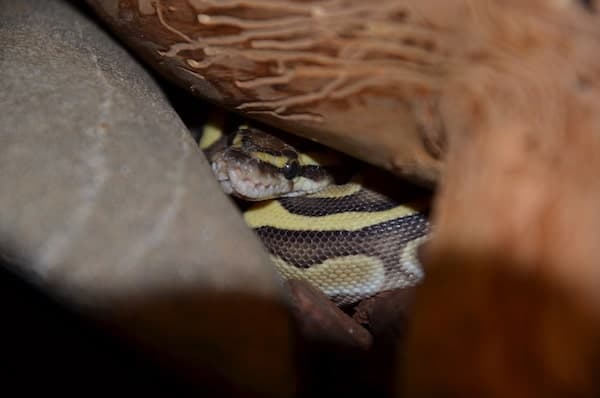
Shedding is simply a part of the natural growth process of the Pastel Ball Python. On average, you can expect your snake to shed once every month to month and a half.
Signs your Pastel Ball Python may be about to shed:
- Their stomach will begin to turn pink
- They will start looking duller in color
- Their eyes will become milky and opaque
If the humidity of the enclosure is at the appropriate level (60% and higher) your Pastel ball python should have no problems shedding by itself.
However, if you notice that your snake is having trouble shedding, increase the humidity even higher and consider assisting your snake by allowing it to soak in shallow water for 2 hours
Also, make sure there is no remaining skin on the tip of the tail or its eye caps as this can lead to infection.
If shed remains, fill a clear bin with lukewarm water up to your pet’s chin, so they’re still sticking out above the water a little.
Let them soak for about 15 minutes, then remove them and let them work against your hands and fingers. Very gently, you can try and manipulate the retained shed.
If it doesn’t want to come off – DON’T force it! Simply repeat the soaking process daily.
Potential Health Issues
Overall, Pastel ball pythons are known to be hardy snakes with limited illnesses. However, most notable illnesses can be attributed to poor husbandry and stress.
As such, if you can maintain a proper enclosure and minimize stress, your snake should remain in good health. Take a moment to study the most common signs of good (and bad!) health below…
| Signs of a Healthy Pastel Ball Python: | Signs of an Unhealthy Pastel Ball Python: |
| Normal Appetite | Lack of Appetite/Refusing to Eat |
| Proper Weight Maintenance (adults only) | Wheezing or Open Mouth Breathing |
| Zero Problems Shedding | Rapid Weight Fluctuation (adults only) |
| No Visible Scratches or Missing Scales | Problems Shedding |
| Increased Shyness or Refusal to Be Handled |
Some Common Illnesses in Pastel Ball Pythons are:
- Ticks and Mites: Usually treated with specialized treatments or an at home DIY treatment if caught early
- Incomplete Shedding: Usually due to low humidity and treated with increasing humidity or soaking snake in water
- Respiratory Infections: Wheezing or trouble breathing due to low humidity and may require antibiotics
- Scale Rot: Rashes and blisters on the skin, due to excessively high humidity levels and treated with lowering of humidity
Note that when a Pastel is crossed with the Spider morph, this produces the Bumblebee Ball Python—a morph that is prone to developing kinking and head wobbles.
Behavior & Temperament
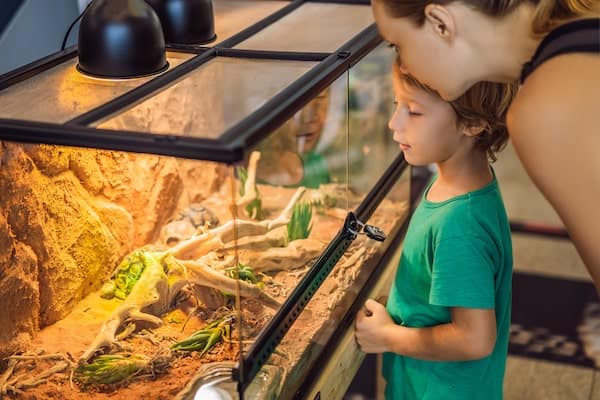
Unlike humans, Pastel Ball Pythons are solitary species. As such, you should never house more than one Pastel Ball Python per enclosure, as fighting and aggression is common.
Ball pythons in general tend to be very easygoing snakes with wonderful temperaments that make them great for beginners and children alike! Although you are unlikely to witness their full personality initially as they can be quite shy in new homes.
However, once your new snake has had time to acclimate to their surroundings, you’ll notice their curious and friendly demeanor. These curious little snakes will often stick out and flicker their tongue. This is their way of exploring their environment and sensing new things.
As with all other ball python morphs, the Pastel Ball Python will coil into a ball when frightened. This is their natural anti-predator behavior and indicates that something has spooked your pet!
Expect to see your snake most active at dawn and dusk as ball pythons are nocturnal.
Handling
Do NOT handle your Pastel Ball Python the first one to two weeks after you bring it home. Handling too early can induce stress and illicit a rare bite.
Before handling, you’ll want to ensure your snake is eating AND defecating. This will demonstrate they feel comfortable in their enclosure and are adjusting well.
Additionally, you’ll want to avoid handling 24-48 hours post feeding and while your snake is shedding.
Pastel Ball Pythons should be handled at least 1-2 times a week, and not more than once daily. Handling too frequently can stress them out. Refrain from making sudden, jerky movements.
When holding your Pastel Ball Python, ensure that their entire body weight is supported. It is normal for them to wrap around you gently so that they are balanced.
However, if your Pastel Ball Python begins to squeeze, it is an indication that it feels uncomfortable! If this happens, gently and slowly peel your snake off your body, from the tail to the head and place it back into its enclosure.
Although the squeeze will not hurt you, squeezing is never a good sign and the snake should be released and allowed to relax.
🤓 Expert Tip: Pastel Ball Pythons will use their sense of smell to identify their owners. One way to acclimate your snake to your scent is to leave a piece of worn clothing, such as a t-shirt, in your Pastel Ball Python’s enclosure when you first bring it home.
Do Pastel Ball Pythons Make Good Pets? A Summary.
Pastel Ball Pythons are a highly adaptable species, able to thrive in all types of environments and enclosures, as long as their simple basic necessities are met! These beautiful snakes make for wonderful pets for owners of all levels of experience.
Additionally, their genetics make them ideal for those looking to create new morphs down the line or breed a variety of highly pigmented morphs!
As with all prospective pets, consider the costs associated to housing (terrarium, lights, humidifier, thermometer, hygrometer, décor), cost of feeding and substrate, and the cost and difficulty of finding an experienced exotic animal veterinarian, before committing to a Pastel Ball Python.
You’ll also be wise to consider their long lifespan as the LAST thing any pet owner will want is to potentially outlive their pet or have to re-home them down the line.
If you’re confident you have the means and finances to provide wonderful care for their entire life AND have been thinking of adopting a ball python for awhile now…
Then we hope this article will give you the confidence and clarity you need to bring home and care for your very own Pastel!
If you stumbled on this article because you’re fascinated with ball python morphs, then you’ll find the Fire Ball Python just as intriguing.
And if you just can’t get enough of morphs with vibrant colors, then check out the Orange Dream Ball Python!
